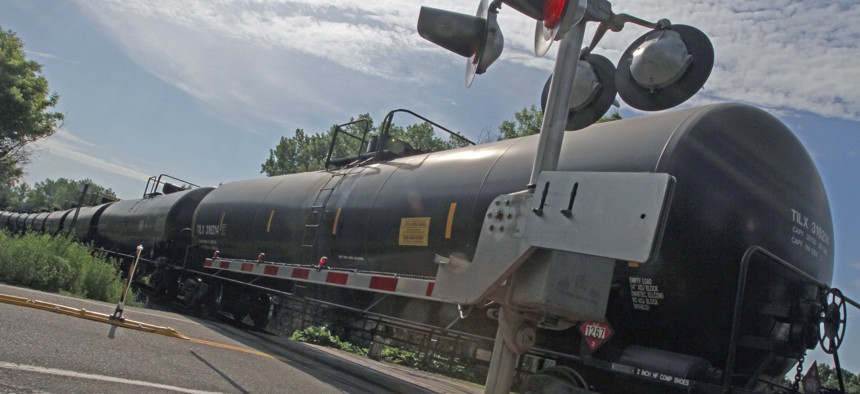State AGs Urge US Supreme Court to Address Blocked Railroad Crossings

Bruce Bisping/Star Tribune via Getty Images
The problem of trains blocking roadways is getting worse and, according to 18 states, it can have life-threatening consequences.
Eighteen states are asking the U.S. Supreme Court to hear a case that could affect their ability to regulate railroad crossings and the amount of time freight trains can block local roads.
The attorneys general argued that the problem of trains blocking roadways has become worse, as railroads use longer and longer trains to increase efficiency. “Blocked grade crossings have serious—sometimes life-threatening—consequences for everyday Americans,” they wrote.
“In recent years, too many emergency vehicles have arrived too late to save lives; too many EMTs have risked life and limb climbing over trains to reach those in need; too many fires have burned while emergency crews detoured miles out of the way; and too many communities have been bisected for days waiting for train crews to unblock intersections,” they wrote in a friend-of-the-court brief.
A recent decision in Ohio and several more like it threaten to strip states of their longstanding authority to regulate these grade crossings for safety purposes, the attorneys general argued. Lower courts have determined that federal laws preempt the state rules, even though the federal laws don’t specifically address blocked crossings.
The state attorneys general want the Supreme Court to preserve that authority for states.
“For over a century, state and local authorities have regulated safety at railroad crossings through anti-blocking laws that limit how long stopped trains may block crossings. Those laws not only safeguard public thoroughfares but also ensure passage by emergency personnel to citizens in need,” the attorneys general for the 18 states and Washington, D.C., told the justices in the brief.
Thirty-seven states and the district have adopted statutes or regulations limiting how long trains may block grade crossings. But lower courts have determined that federal laws preempt the state rules, even though the federal laws don’t specifically address blocked crossings.
The Federal Railroad Administration collects complaints of trains blocking local roads, the lawyers said, but leaves enforcement actions up to state and local authorities. In fact, the FRA only investigated 900 of the 18,000 incidents that residents reported in 2020 and 2021.
The states where the most incidents were reported were Ohio, then Illinois, Texas, Indiana and Colorado. Courts have struck down anti-blocking laws in three of those states (Ohio, Illinois and Indiana).
The states that supported Ohio’s appeal to the U.S. Supreme Court are Alabama, Connecticut, Delaware, Idaho, Indiana, Kansas, Kentucky, Michigan, Mississippi, Montana, Nebraska, Oklahoma, Oregon, South Carolina, Texas, Virginia, Washington, West Virginia and the District of Columbia.
In the Ohio case, state prosecutors charged CSX railroad in 2018 with violating a state law five times that prohibits trains from blocking roads for more than five minutes at a time, a misdemeanor. The rail company frequently stopped trains for as long as an hour to load and unload supplies at an auto factory northwest of Columbus.
CSX argued that Ohio’s law overstepped the state’s authority, because federal laws govern many aspects of the railroad industry. It cited two specific laws: the so-called Termination Act that created the federal Surface Transportation Board, which oversees rail carriers, and the Federal Railroad Safety Act, which governs safety aspects of rail operations.
A divided Ohio Supreme Court sided with the railroad in August. A three-judge plurality of the seven-member court found that the Termination Act preempted Ohio’s laws on stopped trains. The federal law deals with many aspects of railroad operations, the state high court reasoned, which the Ohio law would interfere with.
“Consequently,” Justice Sharon Kennedy wrote for the plurality, “it takes little effort to conclude that [the Ohio law] directly regulates rail transportation.”
On the other hand, the justices voting with Kennedy found that the Safety Act did not preempt Ohio’s law on train blockages.
Two other judges agreed with her conclusion but not with her reasoning. They said it was the Safety Act, rather than the Termination Act, that prevented Ohio from enacting the anti-blocking statute.
“Although I personally think the applicable federal law does not adequately protect the public, my hands are tied,” Justice Patrick Fischer wrote in the concurrence. He urged Congress to clarify who has legal jurisdiction over blocked railroad crossings. “We would all benefit from additional guidance that encourages safety and uniformity in all jurisdictions.”
The final two judges dissented, finding that neither of the federal laws prevented Ohio from enforcing its law. “Since the federal government has not acted to protect citizens from the effects of railroad cars that block crossings, nor granted impunity for the blocking of crossings, the Ohio Legislature is permitted to enact laws to protect the safety of Ohio citizens in this scenario,” Justice Jennifer Brunner wrote in the dissent.
Daniel C. Vock is a senior reporter for Route Fifty based in Washington, D.C.
NEXT STORY: The D.C. Mayor Wants ‘Decisive Action’ on the Federal Government’s Return to Office Plans






